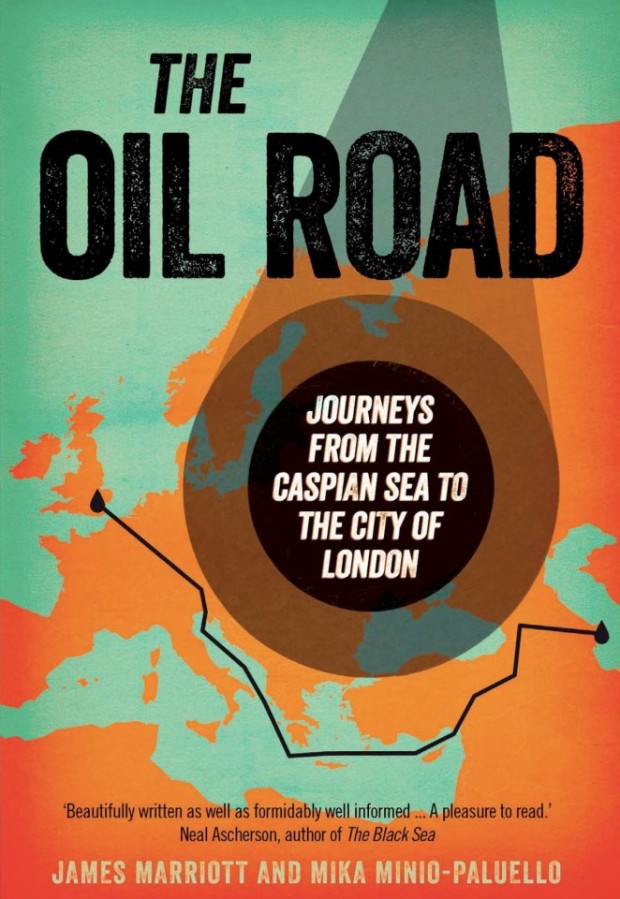The Oil Road: Journeys from the Caspian Sea to the City of London’ – extract 2: day 3

This is an extract from the book ‘The Oil Road: Journeys from the Caspian Sea to the City of London’, by James Marriott and Mika Minio-Paluello of PLATFORM, which traces their journey along the Baku–Tbilisi–Ceyhan oil pipeline. A previously published extract can be found here.
DAY 3, 17:55 – 815 NM – 3,464 KM – SOUTHERN IONIAN SEA, MEDITERRANEAN
The vast engine room of the Dugi Otok oil tanker, like a great hall several storeys high, is the realm of the chief engineer: heavy machinery, whirring shafts, grease and more grease. To walk along the multiple metal gangways is like entering a power station that burns hydrocarbon fuels in order to generate electricity, desalinate water and drive the ship onwards. Most large vessels can run on both diesel and heavy fuel oil. The latter carries a high sulphur load, which makes the emissions from the tanker’s funnel far more polluting than diesel. Under EU regulations it cannot be sold to vessels at European ports, but there is no restriction on ships burning it as they pass through European waters. Consequently, many shipping companies fill the fuel tanks of their vessels with the cheaper, heavy oil when in non-EU ports. The Dugi Otok’s 6S60 MC-C engine was designed to burn primarily this heavy fuel oil.
Forcing a vessel like the Dugi Otok across the Mediterranean requires vast quantities of energy, especially on this outward journey from Ceyhan to Trieste when she is fully laden and low in the water. Very large crude tankers use 62 tonnes of heavy oil every day to power their engines. At $800 dollars a tonne, the daily fuel costs almost hit $50,000 just to move it forwards. But as the Dugi Otok ploughs through the Ionian Sea, the threat to the environment comes far less from what is burned in her engine room and issues from her funnel, than from what is contained in her hold.
In his 1997 Stanford speech, CEO John Browne committed BP to ‘control its own carbon dioxide emissions’, and indeed the company made efforts to make its oil rigs, refineries, road tankers and offices more energy efficient – which of course also reduced costs. However, this efficiency drive did not extend to the contractors it hired or the ships that it chartered. As BP’s own Sustainability Reports illustrated, the carbon dioxide released by the extraction processes of the company, at its oil rigs and so forth, were dwarfed by those released by the products it sold. Of the combined total of these two categories of emissions, 94 per cent came from what the company sold. The raison d’être of the corporation is to generate a return on capital, and this exerts a constant pressure to increase the volume of oil and gas it sells.
The sheer scale of the carbon that the company delivers to the atmosphere needs to be understood. In 2006 the UK’s annual domestic emissions constituted 2.5 per cent of those of the entire world. In the same year BP’s total emissions represented 5.6 per cent of the global total. This one company was responsible for over twice the combined amount of carbon dioxide produced by 62 million British citizens. These raw statistics indicate that, if the company were truly to go ‘Beyond Petroleum’, it would change out of all recognition. It would need rapidly to retire those assets that deliver carbon to the atmosphere, such as its tanker fleet, the BTC pipeline and the Azeri–Chirag–Gunashli oilfield. Even if Browne and his colleagues tried to alter the path of BP with the best of intentions, the company remains fundamentally embedded in the extraction of oil and gas, and hence, like the Dugi Otok, very difficult to turn around.




Leave a Reply